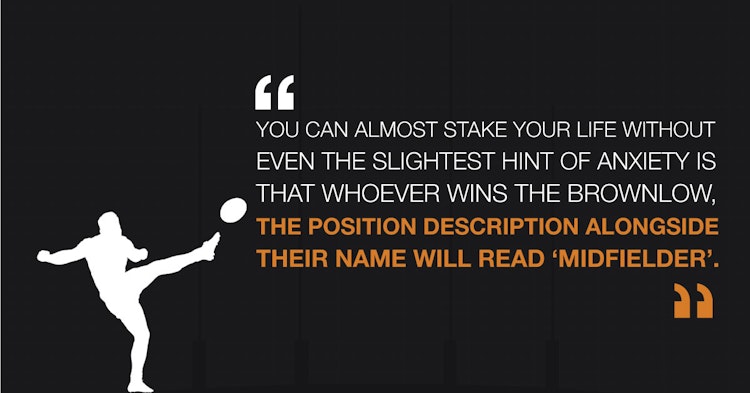Why Do Midfielders Have A Monopoly On The Brownlow Medal?
Last updated: Sep 13, 2021, 6:44AM | Published: Sep 13, 2021, 4:15AM
The 2021 Brownlow Medal will be awarded on Sunday evening, and all indications are it’s going to be a tight race between three players – Port Adelaide’s Ollie Wines, Melbourne’s Clayton Oliver and Western Bulldog Marcus Bontempelli.
Perhaps St Kilda’s Jack Steele or another Demon in Christian Petracca might spring a minor surprise. Maybe there might be an even bigger shock, and this year’s medal will be draped instead around the neck of Carlton’s Sam Walsh or Essendon’s Darcy Parish?
But that’s about where the speculation ends. And the one thing upon which you can almost stake your life without even the slightest hint of anxiety is that whoever wins, the position description alongside their name will read “midfielder”.
That’s what it has read for every year since 1993, when Essendon’s Gavin Wanganeen won the medal playing in a back-pocket. And back then, that was no mere anomaly.
RELATED: Check out all of Stats Insider's Brownlow Medal projections
There’s been plenty said about what has become the “midfielders medal”, but what’s often overlooked is how quickly and completely ground level on-ballers have come to dominate the Brownlow count following Wanganeen’s win.
The two medals prior to the young Bomber’s victory had both been won by ruckmen – Footscray’s Scott Wynd and Melbourne’s Irish recruit Jim Stynes.
St Kilda full-forward Tony Lockett was a joint winner in 1987, another back-pocket in Footscray’s Brad Hardie won the gong in 1985, and the two Brownlows prior to his were won by Melbourne ruckman Peter Moore and North Melbourne’s centre half-back Ross Glendinning.
Indeed, there was a period where just being a ruckman or a key position player seemed to have you halfway to a Brownlow Medal, Barry Round and Bernie Quinlan winners in 1981, forward Kelvin Templeton in 1980, Peter Moore’s first medal won with Collingwood coming in 1979, and three more ruckmen winning three years in a row from 1975-77 in Gary Dempsey, Graham Moss and Graham Teasdale.
In other words, between 1975-92, only eight of 21 Brownlow medallists, fewer than half, were ground-level midfielders, the likes of Greg Williams, John Platten and Gerard Healy.
And since Williams won his second Brownlow as a Blue in 1994? Well, including his medal, it’s 31 from 31 mids. That’s some turnaround. And worth asking the question as to just why, from the mid-‘90s, umpires have become so obsessed with high-possession winning midfielders to the exclusion of set position players when it came to awarding the votes.
It’s a trend that isn’t only about possession tallies climbing, though that, surely, has been a factor. Even as late as 2005, the AFL’s highest individual possession average (across 18 games or more) was comfortably less than 30, with Bulldog Scott West leading the way with 28.95.
By 2010, though, the AFL was seeing far larger possession hauls. That year, three players had disposal averages of more than 30. It was the same again in 2015. But that figure swelled to five in 2016, nine two years ago, and eight this year with Jack Macrae having just broken Tom Mitchell’s only recently-set record for disposals in a single season.
It’s not just the umpires, though, who find it hard to see past the disposal numbers in the statistics panels. Just about every major media Player of the Year award ends up a pretty accurate reflection of the Brownlow tally.
And coaches views on who the best players are in an AFL game seem to vary dependent upon how closely they view those players. Take last year, for example.
Nine club best and fairest winners – Jacob Weitering, Jordan Ridley, Luke Ryan, Sam Collins, Jack Gunston, Luke McDonald, Darcy Byrne-Jones, Jayden Short and Caleb Daniel – were essentially set position players. Throw in a pair of ruckmen in Riley O’Brien and Nic Naitanui, and 11 of 18 club MVPs defied the Brownlow winner cliché.
But then have a look at the voting in last year’s AFL Coaches Association MVP. The only one of that entire group you will find among the top 20 vote-getters of the award won comfortably by Lachie Neale, the man who would also go on to win the Brownlow, is ruckman Naitanui.
This year’s coaches award was won by Oliver, and the leaderboard is again a very close reflection of Brownlow betting, Bontempelli, Wines and Steele finishing second, third and fourth, and Naitanui and Max Gawn the only non-ground level players in the top 20.
RELATED: So, Who's Going To Win The 2021 Brownlow Medal?
What do you conclude from that slice of data? Probably that it’s only with an intrinsic knowledge of a defender or forward, the specific jobs they are assigned, and how well they carry them out, that the worth of a player who doesn’t spend the vast bulk of his time around the contests can be assessed alongside the high-possession winners.
What else can you conclude if even opposition coaches’ eyes seem instinctively drawn primarily to rival players who get their hands on the football the most than those who stop or kick the goals?
That seems to me a considerable rebuttal of various alternatives to the current system of determining the Brownlow Medal regularly put forward, other than perhaps using club best and fairest counts as the starting point for determining each year’s winner.
That would be clunky and lack the drama and theatre (not to mention the red carpet show) which these days mark the Brownlow Medal ceremony perhaps even more than who actually wins it.
Which is OK, I guess, as long as we accept it for what it is, and not as a definitive pronouncement of who the best AFL player is each year.
Because if you’re a forward, defender and these days it seems, or now even a ruckman, you may as well not bother even turning up.
*You can read more of Rohan Connolly’s work at footyology.com.au
Did you enjoy this article? Join our free mailing list to get the best content delivered straight to your inbox, or join the conversation by leaving a comment below or on the Stats Insider Twitter or Facebook page.



